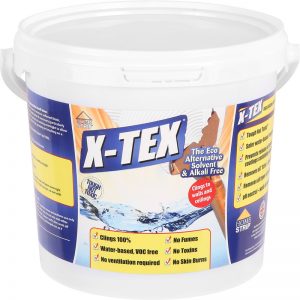
We live in a house in what sometimes feels like Artex capital of the world. Loads of the houses we looked at in March (plus places friends or acquaintances live or have lived), when we bought our current home, are more than liberally coated with this dreadful stuff. In our home it was on almost all flat surfaces, and in numerous places in a really thick heavily textured impasto. I’m only surprised and relieved they didn’t Artex the floors as well!
Fortunately the guy we bought our house off had already done the walls in the downstairs lounge/diner and kitchen. That left us with the bathroom (downstairs, off the kitchen!), almost every single room/surface upstairs, plus all the ceilings, including the sloped under-stairs area, downstairs.
I read about X-Tex online, having googled ‘how remove artex’. What I found I ncluded some glowing reviews of the product, such as some that appear on Amazon’s UK website. So I opted to try it. In the end I used it on the walls in the bathroom, upstairs-landing, and second bedroom, abandoning a partial attempt at the master bedroom ceiling after a messy neck-crick-inducing hour of hell. But it was so messy, expensive, and such incredibly hard work, that work stalled at that point. So we still have quite a bit of hideous Artex to deal with.
Three years have elapsed since I first used it;I’m posting this in 2020, having originally used X-Tex back in 2016-2017. Just recently I’ve considered buying more, and trying again. We would dearly love to be rid of what remains, the very worst of which is in the stair-well area (literally inches thick!). But recalling the horrors of working with it, and then finding it ‘currently unavailable’ when I searched online (Amazon, for example) has saved me from that fate.
In theory it’s a good product. And perhaps on very thin layers of Artex it’s viable? This said, the thinnest Artex-coated area I worked on with X-Tex, our downstairs toilet/bathroom, was still very hard work. And the results were very far from perfect. But I think that was partly because that was the last area I did, and by that point I was exhausted, and heartily sick of both Artex and X-Tex.
Why then would I even momentarily consider trying again? Well, for the same reason I originally went this route, economics; expensive as X-Tex is (or was?) it’s still cheaper than getting a plasterer in. If one opts to plaster over the godawful abomination that is Artex, and I’m thinking here of the areas in our home where Artex was very thickly applied, you’re actually looking at losing appreciable space! That’s why removal of the Satanic substance seemed appealing; gain a little room, don’t lose it!
The Artex under our stairs was on plasterboard sheets, fixed to the underside of the staircase. Having reached the end of my tether with both Artex an X-Tex, I ended up opting to simply tear it all down. Our stairs have remained in an open/gutted state ever since, as I continue to ponder how best to proceed. Anyway, having ranted long enough… in conclusion: this X-Tex stuff does kind of work, inasmuch as it does soften Artex. But in our experience the product was A) too expensive, and B) given the thick impasto Artexing perpetrated on our home, incredibly hard work, and horribly messy.
So, better than one (or no stars). But I couldn’t honestly recommend it. Unless, perhaps, you’re a DIY-sado-masochist? I suppose I’ll have to learn to skim plaster myself?
